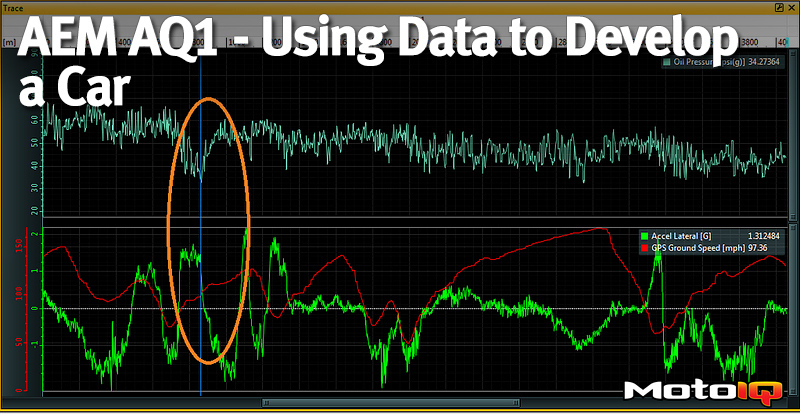,

Globally, the oil pressure follows the trend we would expect: as the oil temp rises throughout the run, the oil pressure falls. Again like the other fluid temperatures, the oil temperature does not hit its steady state value throughout the run and continues to fall. Oil pressure and engine cooling have been huge concerns for us in the past, as we’ve had a lot of issues maintaining good oil pressure and have had head gasket issues in the past. To get a deeper understanding of how well the oil system and engine cooling system are working let’s look at the data trace for Lap 2.


The images above show the oil pressure data for lap 2 in this session. We first can see the global trend of oil pressure falling as mentioned before. What is really important, however, in this trace is to see how the oil pressure behaves during periods of high lateral acceleration. Looking at the oil pressure trace and the acceleration data report, we see periods of high average lateral acceleration at turn 2 through turn 6, the entrance of straight 4, and turn 8 and turn 9. Through these turns we see that the average oil pressure does not go below 80 psi, and is around the 90 – 100 psi range.


Above we have oil pressure data from an event we ran at Road Atlanta back when we had a wet sump lubrication system on the car. At the time we had already done a few engine rebuilds due to oiling issues and we were debating on switching to dry sump lubrication. Naturally dry sump lubrication is very expensive, so it had been put off for a long time due to budgetary constraints. However, the data from this event solidified the need to go to dry sump lubrication. The orange circled region in the oil pressure data trace shows the most alarming section of this run, where the car switches from a high lateral acceleration left hand turn to a high lateral acceleration right hand turn. The oil pressure drops down to 32 psi while the car is gaining in speed and the engine is increasing in RPM. The base system oil pressure for the car was already low, and the oil pressure dropping to such a low value while the engine is increasing in RPM is just asking for crank bearing issues. Looking at the oil pressure channel report, we see that the average oil pressure was around 49 psi. Considering the alarmingly low oil pressures in the car, and the amount of engine rebuilds that we had to do coming into this event it did not make sense to continue any longer without investing into a dry sump system. Comparing the 49 psi average oil pressure with the wet sump to the 90 psi range oil pressure post dry sump we feel that this was money well spent.



